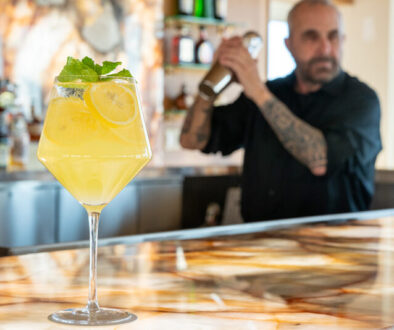The Seafood Paradox

Of course, we need a pair of docks for all the fishing boats. Of course I went for the cheap pun. Unfortunately, there really is a seafood paradox in Cape May. I am always astounded by the amount of people who live or vacation on an island who don’t like or eat seafood. You do have your seafood dabblers who eat shrimp, salmon, and scallops. That is the foodie world’s equivalent of going to church on Easter and Christmas only.
The oceans present a substantial variety of sustainable treats. Sad to say, most restaurants serve the same five or six basic seafood items. Shrimp, lobster, crab, scallop, clams, oysters, and calamari for your non-finned ocean critters. Fish receive even less representation. Salmon, not even a local fish, is a throwaway item for chefs. It is saltwater chicken. Most salmon is farm raised in conditions like the poultry industry, and with bird flu outbreaks seemingly every other week, not the best business model to emulate. Is there truly any “local” seafood left? Yes, but only if you have a rod and reel.
Farm to table, boat to table is mostly a fairy tale concocted by the restaurant industry to make people feel better about overpaying for small portions of mediocre food. Industrialization and globalized food sources have transformed what was once the world’s pantry into a dystopian stew of additives, preservatives, and technology tricks to make food look more appealing while simultaneously making it less safe to consume.

Most fresh seafood on the market is really just freshly defrosted. To be sure there is real fresh seafood out there—for a price. Recent industry studies indicate that up to 75% of retail seafood is mislabeled. Red snapper and grouper are two of the most commonly mislabeled fish. Mislabeling is really a pseudonym for fraud. This is not a new trend, but it has intensified in recent years. When I was starting out in the culinary field, skate wings were punched out and sold as scallops.
Seafood isn’t the only food fraudulently served to diners. Pork was often substituted for the more expensive veal, and lesser beef cuts substituted for more expensive cuts. Technology has enhanced this fraud. Tuna and beef are pumped full of carbon dioxide to look more palatable beyond its natural shelf life. Fruits and vegetables have long been victims of these shady practices as producers seek to preserve their profits at the expense of their customers’ health.
The only true way to restore our food supply is to blow up all the conglomerates and go back to a hunter-gatherer lifestyle or live on a farm and self-produce everything you need to live. This can’t work for most people; I myself can’t hunt for my own food—I don’t even know where Little Debbie lives.


Discernment and skepticism are a shopper’s best tools. The surest defense against food fraud is knowing who you’re buying from and knowing what food is native to your area.
Scallops, oysters, flounder, and squid are routinely fished off New Jersey’s coast, and they are also among the more popular selections of diners. To foster sustainability, catch limits have inflated the prices of scallops and flounder in recent years. Oysters, once the staple of the working man’s diet, have been elitist fare for more than half a century. A fried flounder sandwich on white bread with mayo has receded as an inexpensive lunch faster than my hairline. Now you’re more likely to find panko encrusted dayboat jersey flounder on a brioche bun with lemon caper aioli. Nostalgia is the price for growing old.
This month find a reputable fish monger, look him in the eye, and ask what is fresh and local. If you’re in Cape May and they tell you the king salmon and barramundi are their recommendations, run and don’t look back. When you’ve procured your treasures of the sea, turn them into these dishes. Inspired by Greek diners of my misspent childhood is the feta stuffed grilled calamari. Fried flounder on Maiers sliced Italian bread (marketing irony at its best) with tartar sauce. For the scallops, try making coquilles St. Jacques, the personification of old school cool. For the oysters, the local salts are better raw than cooked but if you can procure some larger local oysters, try this throwback to the 20th century, South Jersey oyster pie.
Recipes from this issue







